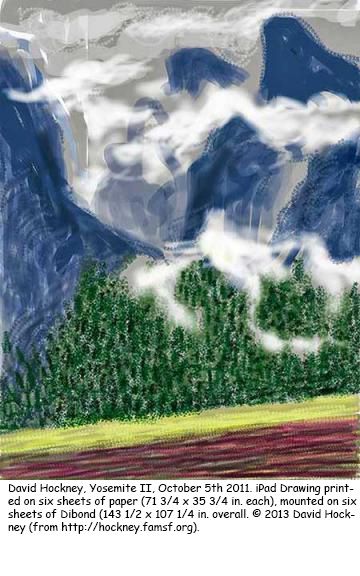Creativity
The Extraordinary Views of David Hockney
New works by David Hockney offer us everyday views with unending depth.
Posted November 12, 2013
As much as I love art, I am not one who regularly experiences that "wow" feeling of intense beauty or awe that many consider the epitome of an art experience. For such feelings to occur, I have argued that all three essential psychological components—sensations, knowledge, and emotions—must be jacked up to 11 on a scale of 10 (see Experiencing Art: In the Brain of the Beholder). Amazingly, I had several such "wow" moments at the David Hockney exhibition now showing at the DeYoung Museum in San Francisco. Hockney's large canvases of everyday views, such as a country road or one's backyard, are presented with broad colorful brushstrokes, as if he's casually sketching the scene. Yet the contrast of colors and the subtle sense of place give the paintings what one might call a comfy magnificence. One gallery room displayed four such paintings (one one each wall), and I found myself standing in awe in front of each one. For me, Hockney creates what art critic Blake Gopnik calls the Cezanne Effect, which is “the ability to take a seemingly straightforward look at the world and make it have unending depth" (Gopnik, 2011).
If that weren't enough, there was a set of images displayed on LCD monitors that Hockney created on his iPad. For some of these images, one can watch a video clip of the artwork being created as Hockney stored the sequence of his brushstrokes as he "painted" on his iPad Moreover the vibrancy of these digital images are stunning as the phosphors on a LCD monitor emit a range of colors and brightnesses that cannot be duplicated on any painted canvas (paint can only reflect light, whereas a monitor emits it). A set of these iPad images depicts impressions from a visit to Yosemite National Park, and for some of them Hockney had large 12 x 9 ft prints made. One of my favorite images of the whole exhibition is shown here.

From a conceptual perspective, these prints make us consider the meaning of an "artwork," as they were originally drawn on an IPad and thus there is no original "canvas" on which these images were painted. Indeed, printouts of these images can now be reproduced in exactly the same manner as shown in a musuem and as often as the artist chooses.
If that weren't enough (again), there was a room in which each wall displayed a 3x3 matrix of large LCD monitors that taken together showed a moving image, as if one were driving very slowly along a tree-lined country road. Each wall appeared to show the same country road only taken at different times of the year. My favorite was the snow-encrusted winter scene. These moving images would have looked rather banal had Hockney merely taken a shot from a single movie camera and divided the video up so that each monitor showed a piece of the scene, as if one were looking through a nine-paned window. Instead, Hockney used nine separate cameras each oriented slightly differently, so that when one stands in the middle of the room and views the moving scene, it is as if one is seeing nine slightly different viewpoints at the same time.
These works doubly reflect the Cezanne effect, as they conform to Gopnik's criterion of straightforward views with unending depth, and they play on images with multiple views, which Cezanne himself portrayed in his paintings. Hockney, in these recent works, exemplifies creativity in action. Prior to the exhibition, he was already one of my favorite artists. With this new exhibition, Hockney at age 76, has shown that the spark of creativity emerges throughout one's life, and we should try as he has to foster new ways of thinking at any point in our lives.


